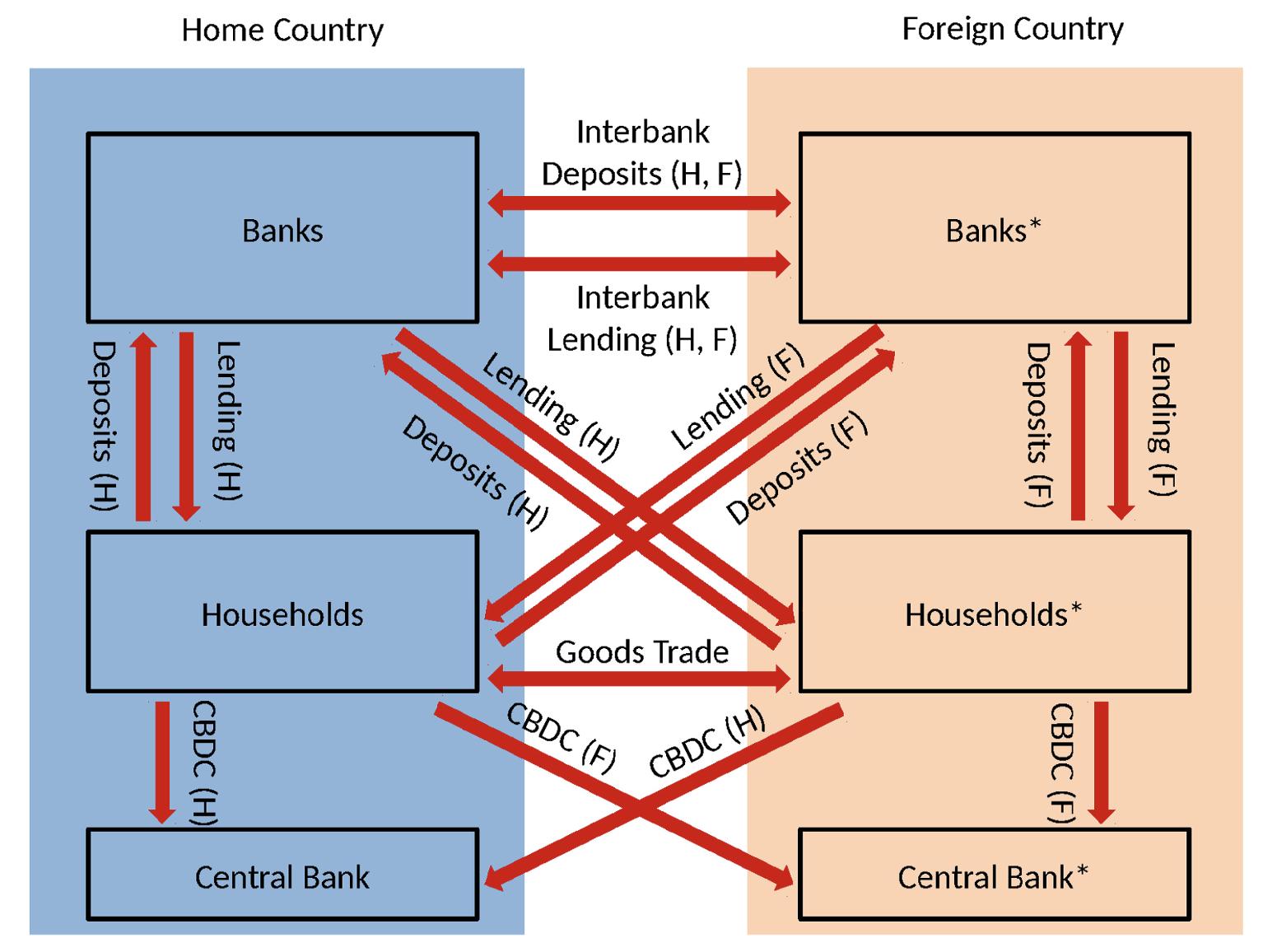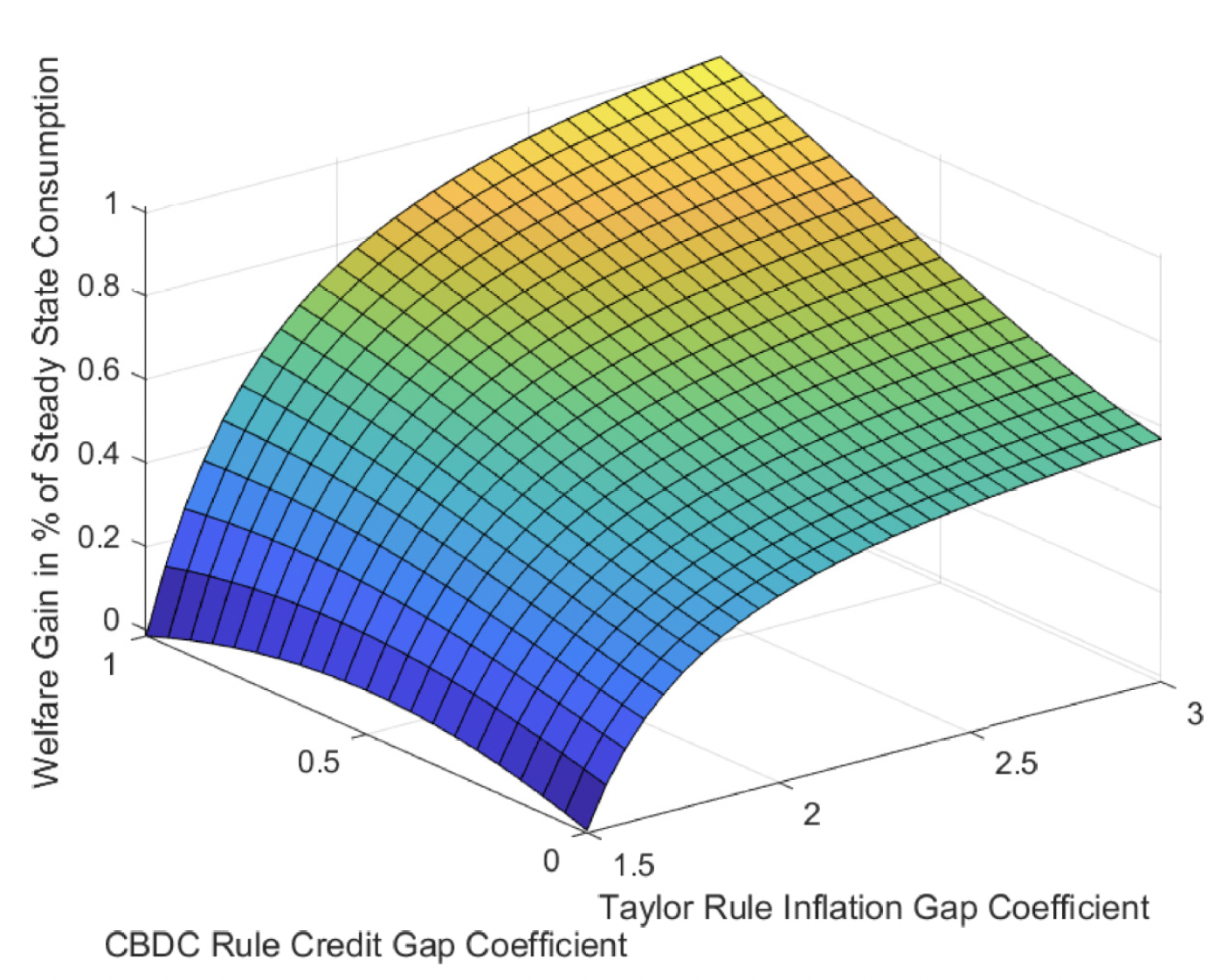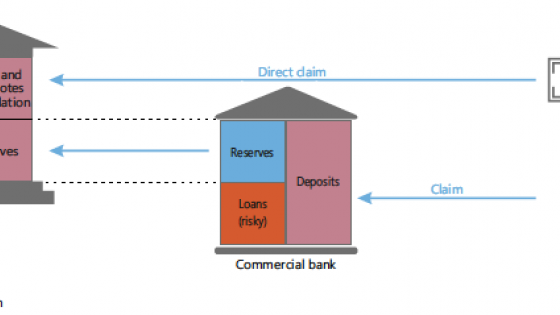Central banks worldwide are actively studying the possibility of issuing digital money to the public, a concept that has become known as central bank digital currency, or CBDC. While the microeconomic and technological benefits of CBDC have so far received most of the attention (Auer et al. 2020, Bohme and Auer 2020 Fatas, 2021), many questions remain unanswered. First, what are the consequences of transitioning to a CBDC economy? Second, how should central banks design CBDC policy rules, in conjunction with a traditional monetary policy rule? Third, what are the open economy implications of CBDC?
Essential macroeconomic features of CBDC
As CBDCs are yet to be widely adopted, one can only tackle these questions hypothetically, in a theoretical environment. We do so in a recent paper (Kumhof et al. 2023), where we analyse the macroeconomic properties of a CBDC characterised by four main features. First, it is accessible to both banks and households/firms (‘retail CBDC’). Second, households/firms are able to hold the CBDC (and bank deposits) across borders and currencies. Third, the retail CBDC is remunerated at an interest rate that is substantially below the interest rate on wholesale central bank reserves, because it provides retail liquidity services.
Fourth, the central bank unconditionally guarantees CBDC issuance only against government bonds. This helps to prevent system-wide runs from bank deposits into CBDC
(Kumhof and Noone 2021).
Our analytical framework is a rich two-country DSGE model, representing the US and the rest of the world. Pre-CBDC, the medium of exchange function is performed by deposits that are issued by banks against collateralised loans. Post-CBDC, it is performed jointly by deposits and CBDC, the latter issued by the central bank against government bonds or through spending. The two are assumed to be imperfect substitutes, for example because they are used by different agents or for different kinds of transactions. Domestic and cross-border gross capital flows arise because households/firms demand bank deposits and CBDC in both currencies, while banks and central banks only issue loans and deposits in their domestic currency. A schematic representation of our model is shown in Figure 1.
Figure 1 A two-country economy where CBDC competes with bank deposits
Note: Figure 1 represents the structure of our two-country model economy, where each country’s central bank issues a CBDC accessible to domestic and foreign residents. In the model, CBDCs coexist with domestic and foreign bank deposits as tools for liquidity provision.
To make our quantitative exercises as realistic as possible, we estimate the pre-CBDC model’s dynamic and policy rule parameters on US data (the steady state is calibrated). We then carry out a number of policy experiments. The transition simulation studies the macroeconomic effects of an overnight issuance of CBDC worth 30% of GDP in one country against an equal amount of government bonds. The CBDC policy rules exercises evaluate the welfare consequences of different specifications and parameterisations of those rules. We also explore the open economy implications of optimising CBDC policy rules.
Initial issuance of CBDC
We find strong positive effects of a transition from a pre-CBDC to a post-CBDC economy, with long-run output and welfare gains of 6% and 2%, respectively, due to a combination of lower real interest rates, lower distortionary taxes, and a larger stock of monetary liquidity. The effects on inflation are small in the short run and negligible in the long run. The main effects are illustrated in Figure 2.
Real interest rates, and fiscal spending on interest charges, drop in the long run. This is both because CBDC carries a much lower interest rate due to its monetary convenience yield, and because CBDC is not defaultable, so that its issuance against defaultable government debt reduces sovereign interest rate premia. Taxes on labour, capital and consumption drop because the reduction in fiscal spending on interest charges creates fiscal space to do so. Monetary liquidity increases because CBDC allows households/firms to satisfy their need for a medium of exchange in a less costly manner than through bank deposits. This brings the economy closer to the Friedman (1969) rule ideal, whereby the money supply should be expanded to where the marginal benefit of money equals its marginal cost.
Figure 2 Short- and long-run effects of a CBDC issuance of 30% of domestic GDP
Note: Figure 2 shows the responses implied by a CBDC issuance worth 30% of domestic GDP. Long run bars represent steady-state values.
Contrary to the predictions of some existing papers (Fernandez-Villaverde et al. 2021, Keister and Sanches 2023), in our exercise banks are not crowded out by CBDC, except modestly during a short transition period that need not even occur if CBDC is introduced more gradually than in our simulation. Bank balance sheets grow significantly in the long run (by around 15% of GDP), due to increased demand for all types of money balances in a growing economy. Banks’ average funding cost remains approximately constant despite greater bank reliance on wholesale funding, due to a concomitant reduction in sovereign interest rate premia.
Evaluating CBDC policy rules
A key insight from our work is that, because CBDC is a medium of exchange, in a recession the central bank should raise rather than lower the CBDC interest rate relative to the interest rate on reserves. The reason is that this reduces the opportunity cost of holding CBDC, which increases the equilibrium quantities of CBDC and of overall money. This money supply transmission channel of CBDC helps stabilise inflation and output alongside the intertemporal substitution channel of the Taylor rule.
As long as the government runs a balanced budget fiscal rule, the best combination of Taylor and CBDC rules can achieve a welfare gain of 1%, relative to a conventional baseline that features a Taylor rule with an inflation gap coefficient of 1.5 and a small output growth coefficient, and a CBDC interest rate rule that maintains at a fixed spread between the interest rates on reserves and on CBDC. About 55% of this welfare gain comes from a more countercyclical Taylor rule, while the rest stems from a countercyclical CBDC interest rate rule with a response to a credit gap. Figure 3 shows the welfare consequences of different parameterizations of these two rules, with welfare gains from a higher inflation gap coefficient in the Taylor rule shown in the north-easterly direction, and welfare gains from a higher credit gap coefficient in the CBDC rule shown in the north-westerly direction.
Figure 3 Welfare gains implied by different values of Taylor and CBDC rule coefficients
Note: Figure 3 represents the welfare gains associated with different combinations of the Taylor rule and CBDC interest rate rule coefficients, where the Taylor rule responds to an inflation gap, and the CBDC rule responds to a credit gap. The coefficients are restricted to be no greater than 3 and 1, to limit volatility in the two interest rates.
We also evaluate alternative CBDC rules, including quantity rules, a response to an inflation gap, rules for a CBDC model that merges wholesale reserves with retail money, and cash-like zero-interest CBDC. All of them, and especially a cash-like zero-interest CBDC, perform significantly worse. An exception is a CBDC interest rate rule that responds to a credit gap combined with countercyclical fiscal deficits, which does significantly better. This is because these deficits are optimally financed almost exclusively with additional CBDC, and therefore represent a manifestation of the Friedman (1948) proposal of money-financed fiscal deficits.
The reason for the superiority of credit gaps over inflation gaps is the important role of persistent financial shocks in driving both financial and real fluctuations, while inflation is much less persistent. The reason for the superiority of interest rate rules over quantity rules is that they allow households/firms to adjust their CBDC holdings more flexibly in response to financial shocks.
Finally, optimal policy calls for a smaller steady state spread between the two interest rates than in our baseline, in other words for a higher CBDC interest rate that implies a higher quantity of CBDC. Specifically, CBDC optimally equals around 40% of annual GDP.
Open economy
Well-designed CBDC policies can reduce the volatilities of cross-border (and also domestic) loan and deposit balances and of the exchange rate by around one third. Global runs into CBDC, under the central bank convertibility rules we propose, would not be runs from bank deposits, but runs from government bonds. Such shocks, even if extremely large, can be flexibly accommodated with small real effects, especially when CBDC is supplied flexibly subject to an interest rate rule. These findings contrast with the results of Ferrari et al. (2020), who show that a cash-like CBDC instead exacerbates macroeconomic volatility in response to foreign shocks.
Summary of policy implications
The introduction of CBDC can produce significant macroeconomic efficiency and stability gains, both domestically and across borders. The key to maximising those gains is a well-designed CBDC policy. Our analysis delivers a set of important insights in that respect:
- CBDC can be highly beneficial for long-run efficiency.
- CBDC can significantly improve macroeconomic and financial stability.
- Risks of CBDC-driven disintermediation are low.
- A higher rather than a lower CBDC interest rate is expansionary.
- Traditional policy rules can be less aggressive when countercyclical CBDC rules are used.
- CBDC interest rate rules are preferable to CBDC quantity rules.
- A CBDC rule should respond to credit gaps rather than inflation gaps.
- A cash-like zero interest CBDC achieves inferior results.
- A single CBDC used both as reserves and for retail transactions achieves inferior results.
- Unconditional CBDC issuance exclusively against eligible securities, plus countercyclical CBDC policy rules, permits a flexible accommodation of financial shocks with minimal real effects.
References
Auer, R, J Frost and G Cornelli (2020), “Rise of the central bank digital currencies: drivers, approaches and technologies”, BIS Working Papers 880 (see also the Vox column here).
Bohme, R and R Auer (2020), “CBDC architectures, the financial system, and the central bank of the future”, VoxEU.org, 29 October.
Brunnermeier, M and D Niepelt (2019), “On the equivalence of private and public money”, Journal of Monetary Economics 106: 27-41 (see also the Vox column here).
Burlon, L, C Montes-Galdón, M Muñoz and F Smets (2022), "The optimal quantity of CBDC in a bank-based economy", ECB Working Paper 2689 (see also the Vox column here).
Fatas, A (2021), “The conflict between CBDC goals and design choices”, VoxEU.org, 3 May.
Fernández-Villaverde, J, D Sanches, L Schilling, and H Uhlig (2021), “Central bank digital currency: Central banking for all?”, Review of Economic Dynamics 41: 225-242 (see also the Vox column here).
Ferrari, M, A Mehl and L Stracca (2020), "Central bank digital currency in an open economy," Journal of Monetary Economics 127(C): 54-68 (see also the Vox column here).
Friedman, M (1948), “A monetary and fiscal framework for economic stability”, American Economic Review 38(3): 245—264.
Friedman, M (1969), The optimum quantity of money, Macmillan.
Keister, T and D Sanches (2023). “Should Central Banks Issue Digital Currency?”, The Review of Economic Studies 90(1): 404–431.
Kosse, A and I Mattei (2022), "Gaining momentum – Results of the 2021 BIS survey on central bank digital currencies”, BIS Paper No. 125.
Kumhof, M and C Noone (2021). “Central bank digital currencies - design principles for financial stability”, Economic Analysis and Policy 71: 553—572.
Kumhof, M, M Pinchetti, P Rungcharoenkitkul and A Sokol (2023), “CBDC Policies in Open Economies”, BIS Working Papers 1086.
Panetta, F and U Bindseil (2020), “Central bank digital currency remuneration in a world with low or negative nominal interest rates”, VoxEU, 5 October.










